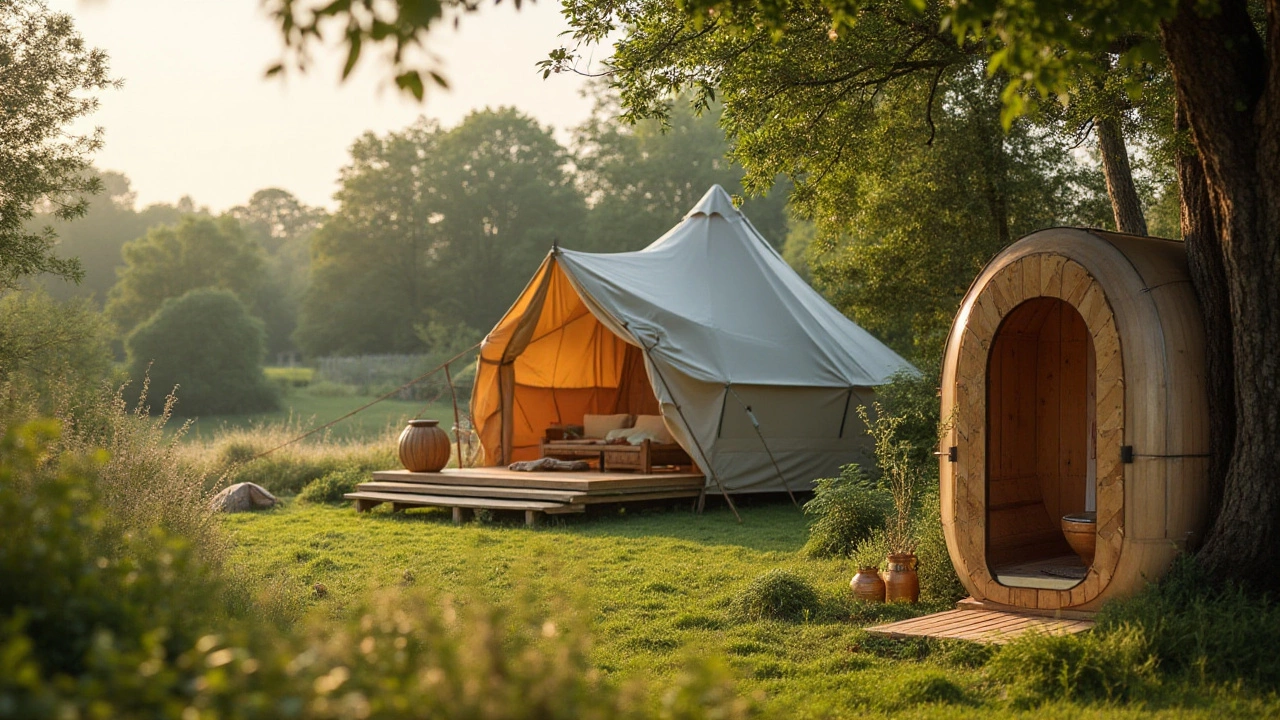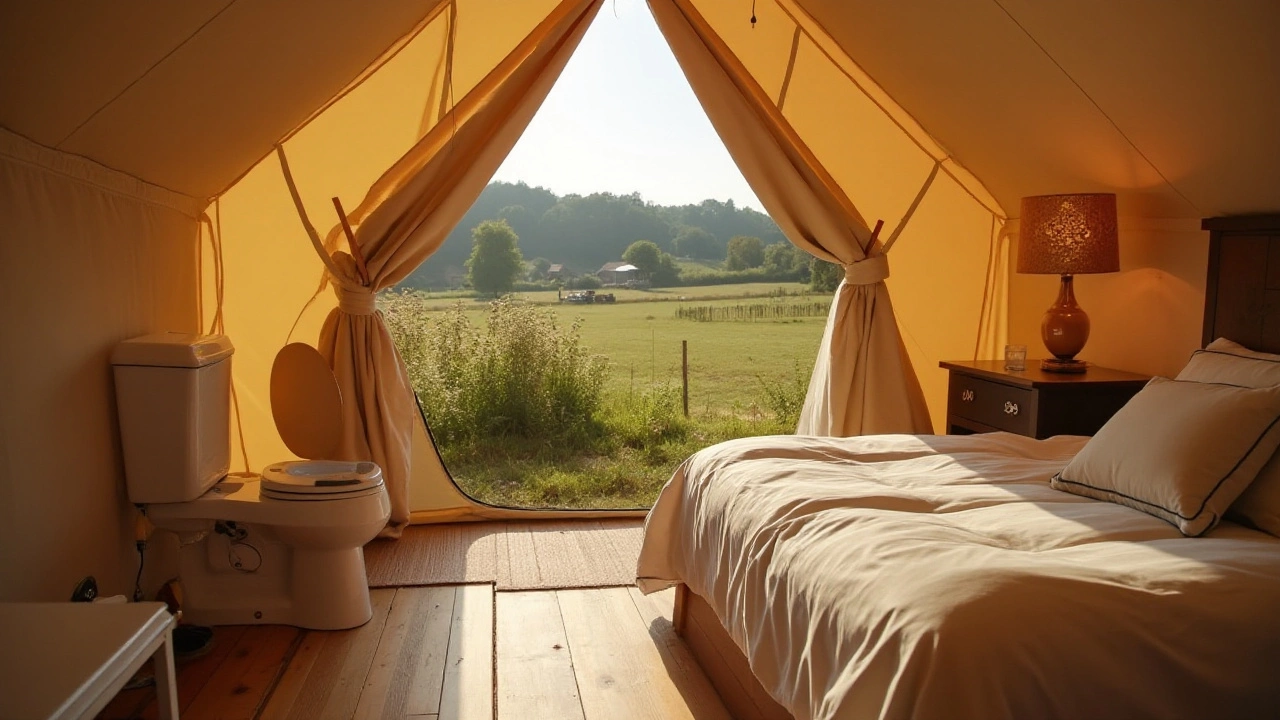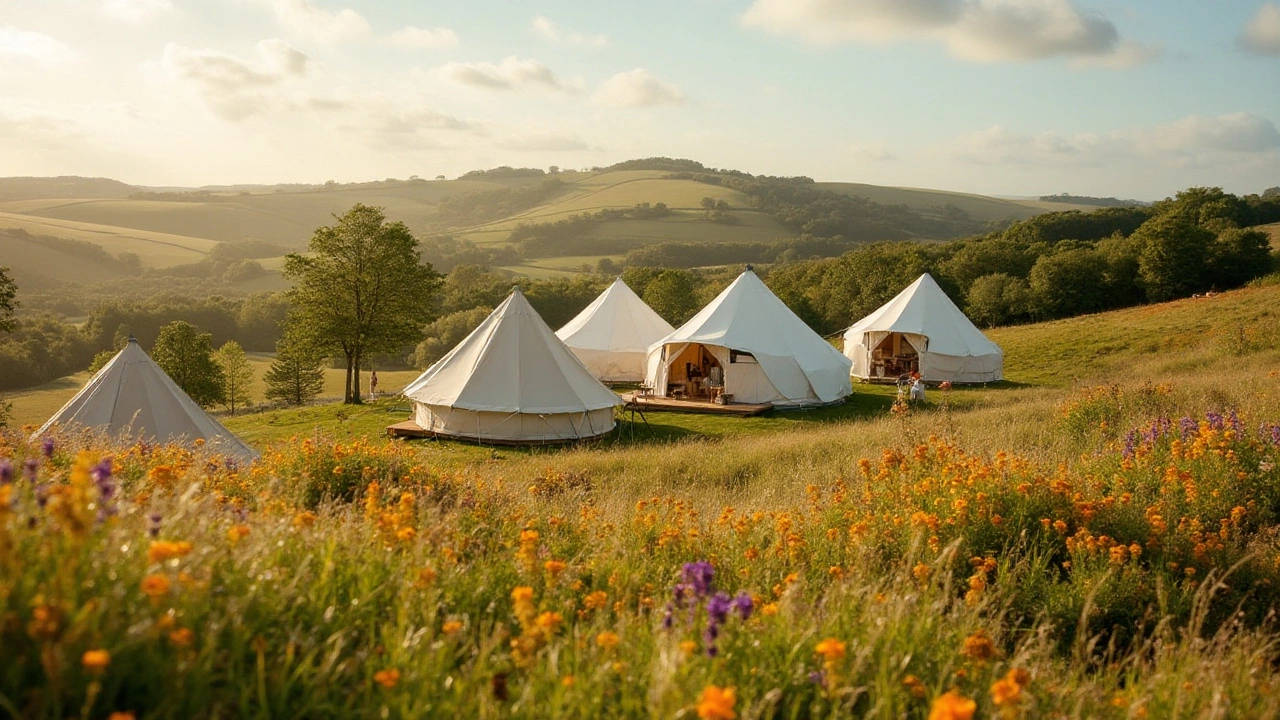Do Glamping Tents Include Toilets? Exploring Eco-Friendly Accommodations
 Jan, 7 2025
Jan, 7 2025
Glamping, the glamorous cousin of camping, presents a unique opportunity for those who love nature but aren't quite ready to give up their creature comforts. You may have wondered whether these elegant tents come equipped with toilets, and it's a fair question! As travelers become more eco-conscious and seek sustainable accommodations, the fusion of luxury and nature becomes ever more appealing.
In the modern landscape of glamping, tents have evolved from simple structures to sophisticated abodes, often equipped with bathrooms. This convenience, however, varies depending on the type of glamping you choose. Ranging from yurts to safari tents, each offers a diverse experience. It's not just about comfort, but also about making sustainable choices that respect the environment.
Stay tuned as we venture into the world of glamping tents, exploring if toilets are included, the kinds of eco-friendly sanitation available, and how to ensure your glamping adventure remains true to the spirit of sustainability. This journey promises insights into selecting the perfect site that harmonizes luxury with nature, all while treading lightly on our precious planet.
- Introduction to Glamping
- Toilets Inside Glamping Tents
- Types of Eco-Friendly Sanitation
- Choosing the Right Glamping Spot
- Tips for a Sustainable Experience
- Future of Glamping and Eco-Sanitation
Introduction to Glamping
Imagine waking up to the sound of chirping birds and seeing the warm glow of the morning sun filter through your luxurious tent. This is the charming world of glamping—an inviting fusion of glamour and camping that offers nature lovers a chance to experience the great outdoors without forsaking modern conveniences. Unlike traditional camping, glamping embraces diversity and modernity, offering diverse lodging options like yurts, safari tents, teepees, and eco-friendly cottages constructed to provide comfort and a sense of adventure. It captures the essence of camping but adds a sprinkle of luxury, appealing to both hardcore adventurers and those seeking a more leisurely encounter with nature.
The concept of glamping truly emerged in the early 2000s, although its roots trace back even further to societies that combined lifestyle with nature. African safaris in the early 1900s are said to be one of the first instances where 'luxurious camping' experiences became popular. Wealthy travelers demanded comforts during their expeditions, resulting in camps equipped with portable bathtubs and Persian rugs. Fast forward to today; glamping has found its place in the heart of the sustainability movement, where eco-friendly practices are celebrated through the creative use of solar energy, compost toilets, and eco-conscious designs.
"Glamping allows us to enjoy the dual luxuries of nature and comfort," says Rachel Brown, editor at The Travel Expert. "It is a bridge for those who are not accustomed to the gritty elements of traditional camping yet yearn to be amid nature."
While some traditionalists may regard glamping as a deviation from the authentic camping experience, others see it as an evolution—an accessible way to reconnect with nature without wrestling with the complexities and discomforts often associated with camping. Many sites today offer tailored experiences, from private chefs and spa services to curated outdoor adventures, establishing glamping as a full spectrum approach to outdoor leisure rather than just its lodging aspects. It allows guests to enjoy the tranquility of the wilderness while staying true to their need for comfort and style, embodying the essence of what Kenneth Grahame wrote in The Wind in the Willows: "There is nothing—absolutely nothing—half so much worth doing as simply messing around in boats."
Today, glamping locations span the globe and each region adds its unique touch, be it Iceland's glass igloos under the auroras, Australia's desert safari tents, or the treehouses dotting German forests. With the rise of social media and travel influencers, these picturesque abodes—often nestled in jaw-dropping landscapes—have become travel bucket list items, enticing wanderers with promises of Instagram-worthy moments. The trend shows no signs of waning, especially as more travelers seek sustainable travel options that reduce their carbon footprint while broadening their travel horizons. The essence of glamping lies in enjoying the simple yet profound pleasures of nature, and through sustainable practices, it invites more people to embrace a lifestyle that respects our planet without compromising luxury and comfort.
Toilets Inside Glamping Tents
The allure of glamping tents often lies in their promise of bringing luxury to the outdoors, fusing comfort with the raw beauty of nature. A common question lingers in the minds of many adventurers: do these serene accommodations include the much-needed convenience of toilets? In today's glamping setups, the presence of toilets is not just a luxury but a reality, albeit with varying degrees of sophistication depending on the style of glamping tent one opts for.
Firstly, it's essential to recognize the diversity in glamping structures which range from bell tents to airstreams and yurts to safari tents, each offering different levels of comfort. In many high-end eco-friendly cottages, you can expect en-suite bathrooms that rival those found in traditional hotel rooms, complete with flush toilets and elegant sinks. These setups cater to those seeking a luxurious escape from the city, without sacrificing the comforts of modern living.
The advancement of sustainable technology has also introduced eco-friendly sanitation options into the realm of glamping. Some glamping tents feature composting toilets, an alternative known for being environmentally friendly while ensuring the necessary conveniences are met. These toilets, without the need for plumbing, use little to no water—an attractive feature for eco-conscious travelers. A composting toilet uses natural processes to break down waste, converting it into compost and minimizing environmental impact.
In mid-range glamping experiences, shared bathroom facilities might be available. These common areas typically maintain cleanliness and privacy standards, but they lack the en-suite opulence luxurious glamping offers. Nonetheless, shared facilities can foster a sense of community among campers, providing an opportunity to interact and share experiences while still enjoying a comfortable level of privacy.
For those who prioritize absolute sustainability, off-grid glamping sites offer dry toilets or the use of other innovative systems such as greywater recycling to maintain an ecological balance. Concerned about how this might affect your glamping experience? Rest assured, the ingenuity involved in these sanitation solutions proves that eco-friendly doesn’t mean compromising on comfort. According to Travel + Leisure, "Glamping has revolutionized the way we explore nature, ensuring that even with minimal environmental footprints, luxury is at our fingertips."
Choosing the right glamping site, with consideration of toilet facilities, can significantly impact the overall experience. Those yearning for intimacy might prefer fewer people around, opting for secluded luxury glamping tents with all the amenities. Meanwhile, backpackers seeking a budget-friendly approach might prioritize sharing spaces that offer affordability. It's crucial to weigh these factors according to personal preference and expectations for the trip.

Types of Eco-Friendly Sanitation
As glamping becomes more popular among environmentally conscious travelers, the need for sustainable sanitation options grows. These solutions not only fulfill basic hygiene needs but do so in a way that minimizes impact on the planet. You might be surprised by how innovative some of these options can be. One of the most common is composting toilets, which are a mainstay in the world of eco-friendly cottages and glamping tents. Composting toilets use a natural process to break down waste material into compost, significantly reducing water use and eliminating the need for standard plumbing solutions.
The design typically involves separating liquids from solids, which helps to accelerate the composting process. The end result is a nutrient-rich material that can be used to enrich soil, making it one of the best examples of waste turned resource. According to the Center for a New American Dream, "composting toilets are a viable and eco-friendly alternative to traditional systems," highlighting their growing acceptance in sustainable travel accommodations.
Another innovative approach includes the use of solar-powered toilets. These utilize solar panels to generate electricity needed for waste processing, which can then be treated on-site without polluting the surrounding environment. The treated waste can often be repurposed, aligning perfectly with the reduce, reuse, recycle philosophy. Solar toilets are a great choice where sunlight is abundant, providing not only effective waste management but also a renewable source of power.
Glamping tents with eco-friendly sanitation can also feature rainwater collection systems that feed into the cleaning processes. This can involve sophisticated filtration systems ensuring that water use remains efficient and sustainable. Rainwater collectors can be particularly beneficial in areas where water availability is limited, supporting self-sufficiency and reducing reliance on external supplies. These systems can be complemented by low-flow fixtures that maximize water conservation efforts.
Portable or off-the-grid campsites often employ biodegradable waste bags and chemical-free options that neutralize odors while maintaining environmental integrity. In some instances, eco-sanitation solutions are surprisingly low-tech, yet incredibly effective. Imagine a custom-built outhouse with locally sourced materials, set against a serene natural backdrop, advocating simplicity while still addressing hygiene requirements. Incorporating these methods not only aligns with sustainable living but also enriches the glamping experience.
Choosing the Right Glamping Spot
If you're setting out to enjoy the wonders of glamping, finding the perfect spot can transform your experience from ordinary to extraordinary. With a growing number of locations offering sustainable retreats, the options might seem overwhelming. Start by considering the type of landscape that speaks to your heart. Are you drawn to the majesty of the mountains or the serenity of the seashore? Each environment offers distinct experiences and elements, which can enhance your connection with nature.
Location is only one piece of the puzzle when selecting your ideal eco-friendly cottages. Investigate whether the establishment prioritizes sustainability and environmental stewardship. Look into their waste management and energy usage policies. It might be worthwhile to ask if they strive to minimize carbon footprints and use eco-friendly construction materials. Often, these reputable sites will share such information willingly, displaying certificates or accreditations that attest to their commitment to preserving the environment.
Why Amenities Matter
Comfort goes hand in hand with sustainability, so it’s important to assess the amenities offered by the glamping site. Many locations today blend luxury with practicality, providing toilets inside glamping tents that are designed with the environment in mind. Water-saving showers, composting toilets, and solar-powered appliances can serve travelers who wish to enjoy modern comforts without leaving a substantial environmental footprint. Consider your needs; some may require more amenities than others, particularly if traveling with family or during unpredictable weather seasons.A good tip is to read reviews from fellow travelers who highlight their experiences. Join online travel forums where seasoned glampers share insights about different destinations. This is where you might find hidden gems or valuable advice on what to pack, how comfortable it was, and whether the place truly delivered an authentic natural experience. It's a community of like-minded individuals, bound by the love of travel and respect for nature.
Don't forget to inquire about the location's activities. Whether you're into hiking, cycling, or simply basking in stunning landscapes, it's good to know what's on offer. Many glamping sites are strategically located near trails, water bodies, or historical landmarks, allowing you to dive deep into local culture and environment.
"Glamping is redefining the way we perceive outdoor adventures, providing us a luxurious yet responsible means to explore our planet's unmatched beauty." - The Glamping Association
Considering all these factors, and perhaps arranging a short list of potential locations, can help you select a site that offers both the thrill of adventure and the peace of sustainable living. Each site brings its unique vibe and challenges—embracing this journey will certainly render your trip unforgettable.

Tips for a Sustainable Experience
Embarking on a glamping adventure is all about harmonizing with nature while enjoying modern comforts. To ensure your experience remains sustainable, there are a few key practices to keep in mind. One crucial aspect is selecting a glamping site that upholds eco-friendly practices. Research locations that prioritize sustainability, using renewable energy sources or having strong waste management systems. This not only helps preserve the environment but supports businesses that are committed to eco-friendly operations.
Another essential element is being mindful of your own energy consumption. Glamping sites can vary, with some offering electric appliances while others rely solely on solar power. Try to minimize energy usage by turning off lights and devices when not in use and enjoying the natural ambiance of your surroundings. Similarly, water conservation is critical; utilize resources sparingly, whether it's during a quick shower or while washing dishes. Some glamping sites might have composting toilets that align with sustainable travel values.
Packing sustainable gear can also make a big difference. Opt for reusable items such as water bottles and cutlery instead of single-use plastics. Investing in eco-friendly toiletries, like biodegradable soap and shampoo, can keep local waterways clean. Recycling and properly disposing of waste is another simple yet impactful practice. Bringing your own reusable bags can help organize trash and recyclables, ensuring nothing is left behind.
Avoid disturbing the local flora and fauna. Stick to marked trails and follow guidelines provided by the glamping site to minimize your environmental footprint. Eco-friendly cottages may also offer educational tours, emphasizing nature conservation and the ecosystem you're visiting. Engaging in these experiences can deepen your appreciation and understanding of the natural world, enhancing the quality of your trip.
When planning activities, support local communities by choosing tours and excursions operated by local businesses. This not only empowers the region's economy but often provides a more authentic and enriching experience. Prioritize eco-friendly activities such as hiking, bird watching, or kayaking, which allow you to connect with nature without altering it.
Consider this insight shared by Jane Goodall, a renowned primatologist and conservationist:
"What you do makes a difference, and you have to decide what kind of difference you want to make."The beauty of glamping lies in the blend of indulgence with responsibility, where each decision contributes to a worthwhile difference in the world.
Future of Glamping and Eco-Sanitation
The coming years herald an exciting transformation within the glamping realm, leveraging innovation to enhance sustainability and comfort alike. As the demand for eco-friendly cottages grows, so too does the commitment to marrying luxury with environmental responsibility. Modern-day glamping aficionados are pushing the boundaries, encouraging the development of advanced sanitation technologies that effectively address the environmental concerns associated with camping. These innovations entail a wide array of biodegradable toilets and composting solutions specifically designed to minimize environmental impact while ensuring traveler comfort. More recently, we've seen an uptick in the integration of waterless toilet systems that purify waste through natural processes, an idea that was once the stuff of dreams for sustainable travel enthusiasts.
The ecological footprint of glamping experiences is a subject garnering significant attention from the travel industry. Adopters of the glamping lifestyle are beginning to realize the potential of utilizing environmentally friendly materials and sustainable building practices to construct glamping tents that defy conventional design. Imagine tents equipped with solar panels and rainwater collection systems, reflective of an environmental mindfulness that harmonizes seamlessly with unspoiled natural surroundings. A noteworthy aspect of this evolution is the emphasis on reusability and minimal waste generation, aspects that distinctly separate eco-glamping from its traditional counterpart. Even the idea of using recycled materials for tent structure and furnishings is gaining popularity, contributing to a movement built on principles of sustainability and conservation.
Public consciousness about sustainable practices has been on the rise, aided by insightful experts sharing knowledge and experience.
According to Linda McVicker, an environmental consultant, "Glamping can bridge the gap between city dwellers and nature by promoting easy-to-implement sustainability practices." Her statement highlights the critical role of education and awareness in shaping the future of eco-sanitation in glamping.It's clear that sustainable practices aren't just for show; they're imperative to meeting the travel needs of an audience increasingly sensitive to ecological concerns. The forthcoming years are poised to see even more comprehensive and versatile solutions that encompass everything from transport options to the most intricately devised site amenities. The guiding ethos here is simple yet profound: luxury needn't come at the expense of the planet.
Let’s not forget data insights pointing to a promising rise in consumer preference for sustainable travel solutions. Here's an illustrative table that encapsulates this trend:
| Year | Percentage of Travelers Preferring Sustainable Options |
|---|---|
| 2021 | 68% |
| 2023 | 74% |
| 2025 | Estimated 80% |
These figures underscore a trend that's not simply a passing fad, but a deep-seated desire for change aligned with values that celebrate our world's natural assets. It's becoming increasingly evident that substantive improvements in eco-sanitation are tethered to the legacy seekers wish to leave, underscoring the vital interplay between development and diligence.
In essence, the future of glamping promises a harmony of premium experiences and eco-centric values. Artisans, builders, environmentalists, and every stakeholder in between are now part of a narrative poised to redefine the travel experience. There’s no denying that this balance of luxury and environmental sensibility is not just about tending to the wanderlust spirit, but championing a cause that benefits both the traveler and the earth. The enticing glow of campfires adjacent to serene landscapes beckons a future less about forfeiting conveniences and more about nurturing an ethos characterized by thoughtful choices—a journey of discovery that echoes the heart's desire to do good for mother nature.